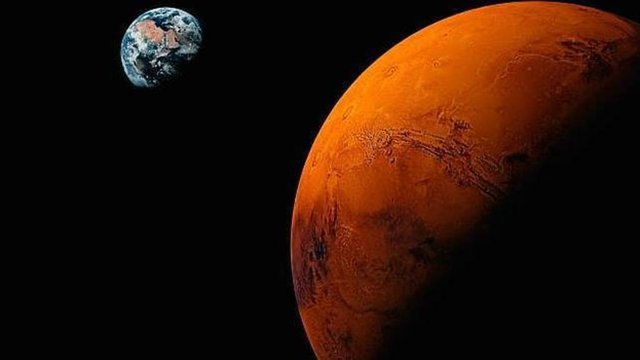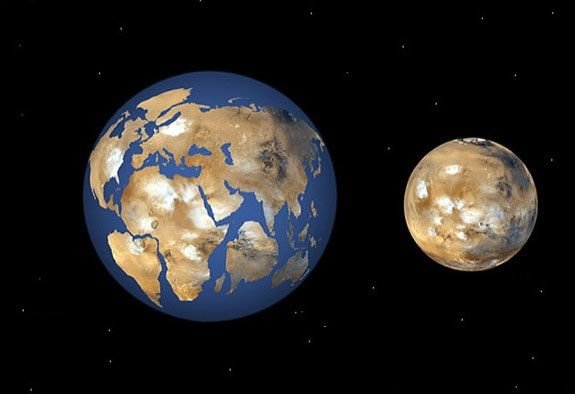Fourth Planet of the Solar System - Tuesday, The Red Planet
Mars is the fourth planet in order of distance from the Sun and the second smallest in the solar system, after Mercury. It received its name in homage to the god of war of Roman mythology (Ares in Greek mythology), and is also known as "the red planet". Due to the reddish appearance that gives the predominant iron oxide on its surface. Mars is the inner planet farthest from the Sun. It is a telluric planet with a thin atmosphere of carbon dioxide, and two small and irregularly shaped satellites, Phobos and Deimos (sons of the Greek god), which could be captured asteroids similar to the asteroid . trojan (5261) Eureka. Its surface features remind as much of the craters of the Moon as of the valleys, deserts and polar ice caps of the Earth.

The period of rotation and the seasonal cycles are similar to those of the Earth, since it is the inclination that generates the seasons. Tuesday hosts Mount Olympus, the largest volcano and the second highest known mountain in the solar system, and the Marineris Valleys, one of the largest canyons in the solar system. The Boreal flat basin in the Northern Hemisphere covers 40% of the planet and can be characteristic of a gigantic impact.
Although it looks like a dead planet, it is not. Its dune fields are still shaken by the Martian wind, its polar ice caps change with the seasons and there even seems to be some small seasonal water flows.

The period of rotation and the seasonal cycles are similar to those of the Earth, since it is the inclination that generates the seasons. Tuesday hosts Mount Olympus, the largest volcano and the second highest known mountain in the solar system, and the Marineris Valleys, one of the largest canyons in the solar system. The Boreal flat basin in the Northern Hemisphere covers 40% of the planet and can be characteristic of a gigantic impact.
Although it looks like a dead planet, it is not. Its dune fields are still shaken by the Martian wind, its polar ice caps change with the seasons and there even seems to be some small seasonal water flows.
Studies show that Mars had a more compact atmosphere, with clouds and precipitations that formed rivers. On the surface you can see furrows, islands and coasts. Large temperature differences cause very strong winds. In addition, soil erosion helps form sand and dust storms that further degrade the planet's surface.
Before space exploration, it was thought that there could be life on Mars. The observations have not been able to show if he has it, although he could have had it in the past.
Mars and comparison with Earth
Mars is much colder than Earth. Temperatures on the Martian surface vary from -125 ° C (centigrade) near the poles during winter, to 70 ° C at noon near the equator. The average temperature on Mars is about -60º C.
Mars is so different from Earth for the most part because Mars is much farther from the Sun and much smaller than Earth. The average distance between Mars and the sun is around 227,920,000 kilometers. This distance is approximately one and a half times the distance from Earth to the sun. The average radius (distance from its center to the surface) of Mars is 3,390 kilometers, about half the radius of the Earth.

The moons of Mars
Mars has two satellites, Phobos and Deimos. They are small and spin rapidly near the planet. This hindered its discovery through the telescope.
Fobos has just over 27 km on the longest side. It turns 9,380 km from the center, that is, less than 6,000 km from the surface of Mars, every 7½ hours. Deimos is half of Phobos and travels 23,460 km from the center in just over 30 hours. The most outstanding feature of Phobos is the Stickney crater, which measures 10 km in diameter. Its surface is riddled with shallow grooves, which have a width between 100 and 200 meters, and a depth of 20 or 30 meters. Small wells with raised edges, aligned in parallel formations, could be points where gas escaped from underground ice through fissures. Phobos could have manifested then as a comet.

Deimos seems to be relatively soft when viewed from a distance. However, it is actually dotted with small craters filled with fine materials. Its dimensions are 16x12x10 km. Unlike Phobos, Deimos does not have a single larger crater 2.3 km in diameter. The great similarity between Phobos and Deimos with a certain type of asteroid suggests that Mars has captured two of them, and even more so if we consider that the main belt of planetoids is just beyond the orbit of Mars.
The perturbations generated in Jupiter could have pushed some smaller bodies towards the inner regions of the Solar System, favoring the attraction process. However, the shape of the orbits of Phobos and Deimos is very regular and almost coincident with the equatorial plane of Mars, so this explanation is unlikely.
Another hypothesis is that both satellites were born from the rupture of a single orbital satellite around Mars, as its form attests. But even if they arose from a single object divided by an impact, their origins go back thousands of millions of years.
Mars: Mount Olympus
Mount Olympus of Mars is the largest known volcano in the Solar System. It is located in the western hemisphere of the red planet. It is the youngest of the great volcanoes of Mars; It was formed during the last 1,800 million years. It was known before the Earth spacecraft approached the planet, although its details were not known. The central massif of the volcano rises almost 23 kilometers in the plain that surrounds it. This is three times the height of our Mount Everest, the highest mountain on Earth. It is located in a depression 2 km deep, surrounded by large cliffs that reach up to 6 km in height. Its boiler measures 85 km long, 60 km wide and almost 3 km deep. You can see up to six superimposed chimneys, formed at different times. The base of the volcano measures 600 km in diameter, including the outer edge of the cliffs. In total, the base occupies an area of approximately 283,000 km², equivalent to the Republic of Ecuador or almost half of the Iberian Peninsula.

Mount Marciano Olimpo is a shield volcano. Unlike composite volcanoes, tall and thin, shield volcanoes are tall and broad, with flat, rounded shapes, like some Hawaiian volcanoes. Its impedance height is due to the fact that Mars, unlike Earth, does not have tectonic plates that move and transform its surface. For millions of years, the volcano has released lava in exactly the same place, growing, to form this huge mountain on the surface of the red planet.

https://es.wikipedia.org/wiki/Marte_(planeta)
http://www.astromia.com/solar/marte.htm
http://www.astrofotos.es/Marte.php